Written by: duoduo, LD Capital
The GMX V2 version will be officially launched on August 4, 2023. This article reviews the development and existing problems of GMX V1, compares the modification of V2, and analyzes the possible impact.
1. GMX V1: an effective model for the derivatives DEX protocol
The GMX V1 version was launched at the end of 2021. The GLP model adopted provides a concise and effective trading model, creating a narrative concept of "real yield", which plays an important role in the derivatives DEX protocol. Many projects have forked the GMX V1 model.
The GMX V1 protocol captures a significant amount of fees. Since 2023, the revenue of GMX V1 agreement is 98.1 million US dollars, ranking eighth among all projects, and ranking first in the derivative DEX track.

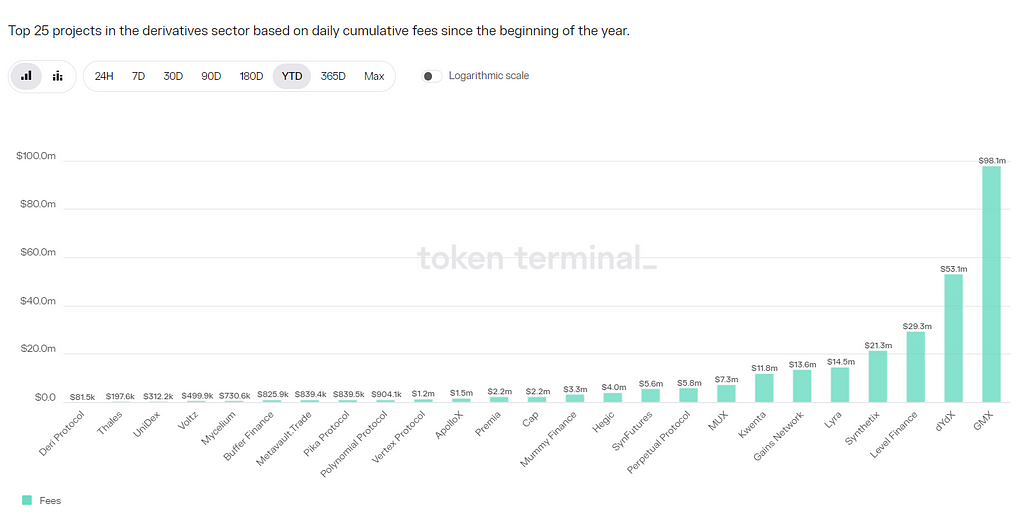
Source: token terminal
However, GMX V1 also has limitations, mainly including:
1. The imbalance of open interest (OI) leads to greater risks for LP providers
The fees for GMX V1 are opening/closing fees and borrowing fees, and there is no funding rate. Borrowing fees make holding positions costly, so as to avoid liquidity being occupied indefinitely. In addition, the dominant party needs to pay more fees, but since both long and short parties are charged fees, there is no room for arbitrage, and open positions cannot be quickly restored to balance through arbitrage behavior.
However, if this balance is not dealt with, in extreme cases, the GLP pool will face huge losses, and LP providers will suffer losses, which will lead to the collapse of the agreement.
2. Less tradable assets
There are only 5 tradable varieties in GMX V1, BTC/ETH/UNI/LINK and AVAX. And DYDX and Synthetix can provide dozens of trading varieties. Gains provides foreign exchange trading varieties. The new platform HMX provides varieties of commodities and US stocks.
3. Higher fees for small and medium traders
The opening fee and closing fee of GMX V1 are both 0.1%, which is a relatively high fee. In the case of the inversion of the derivatives DEX track, the fees of many agreements are below 0.05%.
2. GMX V2: Guarantee the security and balance of the protocol
1. Core
The core of GMX V2 is to ensure the security and balance of the protocol, and maintain the balance of long and short positions by modifying the fee mechanism, so as to reduce the probability of systemic risk in GMX when it faces severe market fluctuations. Through the setting of the isolation pool, high-risk trading assets are increased while controlling the overall risk. By cooperating with chainlink, we can provide more timely and effective oracle service and reduce the probability of price attacks. The project party also considered the relationship between traders, liquidity providers, GMX holders and the continuous development of the project, and finally adjusted and balanced the distribution of protocol income.
2. Fee model adjustment: increase funding rate and price impact fee
The charging model of GMX V2 has undergone major adjustments, focusing on how to balance long and short positions and improve capital utilization efficiency. The charging mode is as follows:
Reduced opening/closing fees.
Reduced from the previous 0.1% to 0.05% or 0.07%, the fee will be charged according to whether opening a position is conducive to the balance between long and short positions, and if it is beneficial, a lower fee will be charged.
Increase the funding rate, and the strong party will pay the funding rate to the weak party.
The funding rate will be adjusted step by step. When the strong party’s position/full position is between 0.5–0.7, the funding rate will be at a low level; when it reaches 0.7, it will be raised to a higher level, increasing the arbitrage space and promoting arbitrage Funds come in, thus restoring the long-short balance.
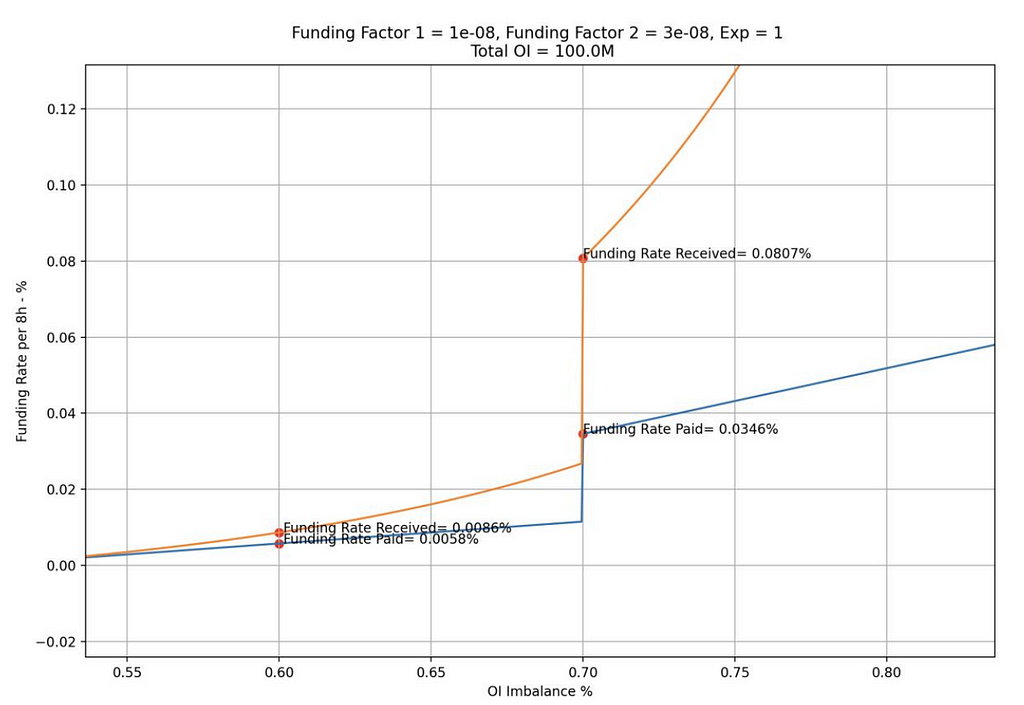
Source: chaos labs
Retain borrowing fees to avoid unlimited liquidity occupation.
Increase the price impact fee, the larger the position, the more unfavorable it is to the long-short balance, the more fees will be charged.
The price impact fee simulates the dynamic process of price changes in the order book trading market, that is, the larger the position, the greater the impact on the price. This design can increase the cost of price manipulation, reduce price manipulation attacks, prevent flash crashes or soaring prices; and maintain a balanced long-short position and maintain better liquidity.
The figure below shows the price impact rate faced by different opening sizes in the simulation state. It can be seen that the larger the position, the higher the rate. The horizontal axis is the opening size (millions of dollars), and the vertical axis is the rate (bps).
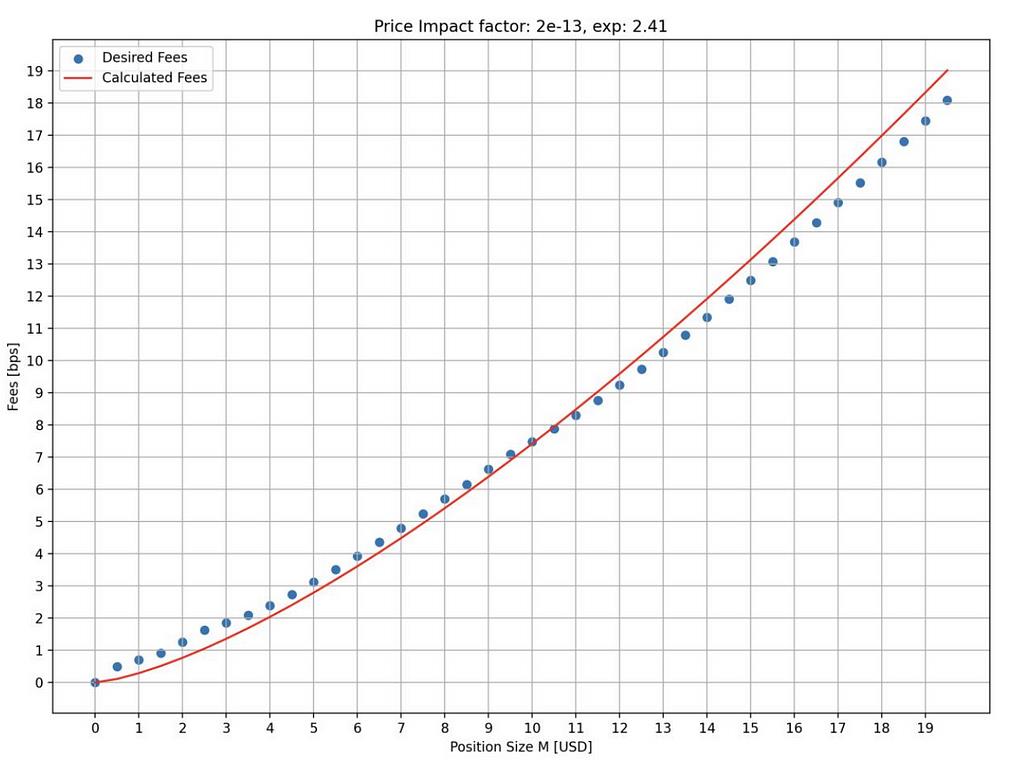
Source: chaos labs
In addition, if opening a position is more unfavorable to the long-short balance, the fee will be higher. The following table shows the fees charged under different long-short balance states in the simulated state. The first column is the size of the opening position, and the first row is the size of the initial unbalanced position in the pool.

Source: chaos labs
Briefly compare the fees of several major derivative DEX protocols:
DYDX : Maker 0.02%, taker 0.05%, the greater the transaction volume, the greater the discount;
Kwenta : maker 0.02%, taker 0.06%-0.1%;
Gains Network : 0.08% opening/closing fee + 0.04% spread + price impact fee.
It can be seen that the fees of GMX V2 are still high, but, from the previous high level to the middle level, the opening/closing fee has dropped by nearly 50%. For small and medium-sized traders, the fees of V2 are more friendly.
3. Liquidity provision: increase isolation pool mode, increase synthetic assets
The liquidity pool of GMX V2 is called the GM pool, and each pool is independent of each other. You can see the fund amount, fund rate and fund utilization rate of each pool on the official website.

Source: GMX
The advantage of the isolation pool is that different token markets can have different underlying support and different parameter settings to achieve their own risk control, with a high degree of flexibility, thereby expanding trading assets, but the risk is controllable. For liquidity providers, they can also choose risk exposures based on risk appetite/return expectations. The problem with isolated pools is the fragmentation of liquidity. Some pools may not be able to attract sufficient liquidity.
Currently, GMX V2 divides 3 different types of markets:
Blue chips : BTC and ETH. These two tokens are less likely to be price manipulated, so the price impact fee can set a lower rate, which is more competitive than CEX. All backed by native tokens.
Medium market capitalization assets : The market capitalization is between US$1 billion and US$10 billion, and there is relatively large liquidity and trading volume on CEX, but they are susceptible to violent price fluctuations caused by external factors. For example, regulatory news causes a sharp drop in currency prices. For such assets, the price impact fee will be set at a higher ratio, and the liquidity will not be higher than other external markets, which will increase the cost of attack. LINK/UNI/AVAX/ARB/SOL fall into this category. Supported by native tokens.
Medium-cap synthetic assets : Instead of using native tokens, ETH is used as the underlying liquidity support. DOGE and LTC fall into this category.
The problem with this type of asset is that if the related tokens rise extremely in the short term, it may be difficult for the ETH in the pool to pay all the proceeds.
If there are 1000 ETH and 1 million USDC in the pool, the maximum long DOGE position is limited to 300 ETH, but the price of DOGE has increased by 10 times, while the price of ETH has only increased by 2 times, in this case the profit will exceed that of the pool The value of ETH.
To avoid this, the ADL (automatic deleveraging) feature was introduced. When the pending profit exceeds the threshold of market allocation, the profitable position may be partially or completely closed. This helps ensure that the market remains solvent and that all profits are paid in full at the close. But for traders, automatic reduction of positions may lead to the loss of advantageous positions, thus missing out on subsequent profits.
According to a report issued by chaos labs, it is recommended that during the initial operation of V2, the upper limit of the open interest of BTC and ETH is 256 million U.S. dollars, the upper limit of AVAX/LINK is 4 million U.S. dollars, and the remaining tokens are 1 million U.S. dollars. Subsequent adjustments can be made according to actual operating conditions. However, the current total TVL of the GM pool is about 20 million US dollars, which is still far from the upper limit.
4. Improve user experience: increase currency-based contracts, faster execution speed and lower slippage
In GMX V1, traders can only open U-margin contracts. No matter what asset a trader uses to open a position, the position value is calculated by converting the price at the time of opening to USD, and the profit is equal to the USD value at the time of closing minus the USD value at the time of opening.
In GMX V2, currency-based contracts are added. Traders can deposit relevant trading assets as collateral, which will no longer be converted into USD. This will meet more needs of traders and provide a richer investment portfolio.
In addition, the oracle system of GMX V2 will price each block, and the order will be executed at the latest price as much as possible, with faster execution speed and lower slippage.
5. Distribution mode
In order to maintain the long-term development of the project, the protocol income of GMX V2 has also been adjusted. 8.2% will be allocated to the agreement treasury, which can be used for project operations and other matters.
GMX V1 : 30% allocated to GMX stakers, 70% allocated to GLP providers.
GMX V2 : 27% to GMX stakers, 63% to GLP providers, 8.2% to protocol treasury, 1.2% to chainlink. This allocation has been voted on by the community.
3. Operation of GMX V2
GMX V2 has been in operation for about 2 weeks, the TVL is about 20 million US dollars, the average daily trading volume is 23 million US dollars, the average daily agreement income is 15,000 US dollars, the open interest is 10.38 million US dollars, and the daily active users are about 300-500 people. As an initial stage, the performance is acceptable without using transaction incentives.
Some V1 users have been migrated to V2. The transaction volume and daily active users of V2 are roughly equivalent to 40%-50% of the transaction volume of V1. The transaction volume, protocol revenue, and user comparison of V1 and v2 are shown in the figure below:
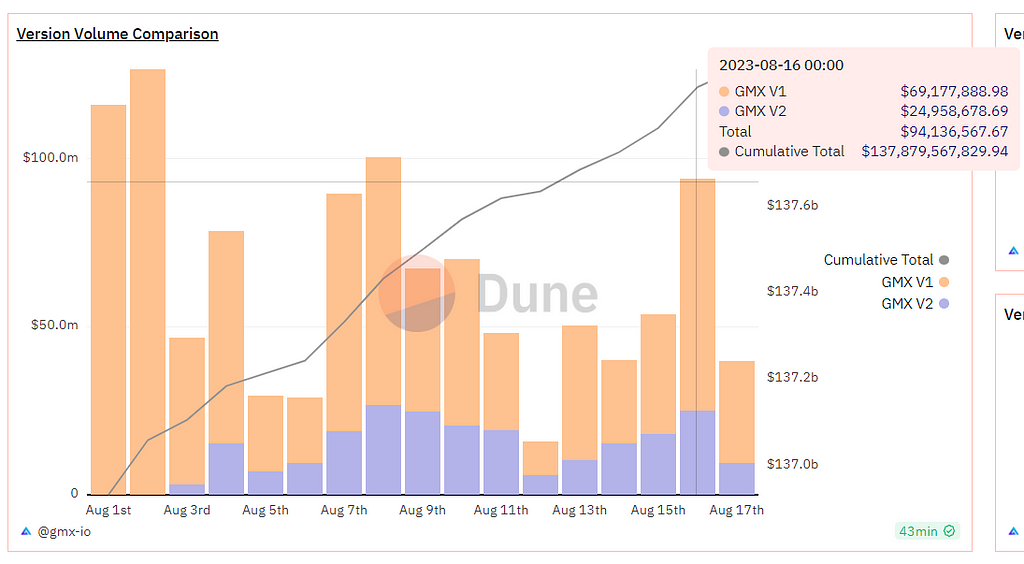

Source: dune
GMX V2 traders are currently in a state of net loss, with a cumulative net loss of $40,000.
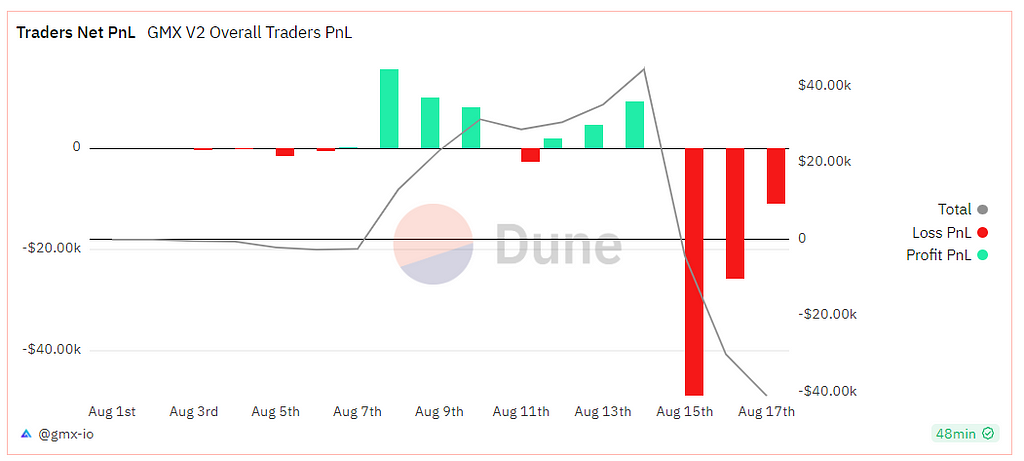
Source: dune
In terms of yield, the yield of GMX V1 has been sluggish recently. This week, the yield of GMX pledged was 1.44%, that of GLP (arbitrum) was 3.18%, and that of GLP (Avalanche) was 8.09%. In comparison, the yield of GMX V2 is higher, the list is as follows:
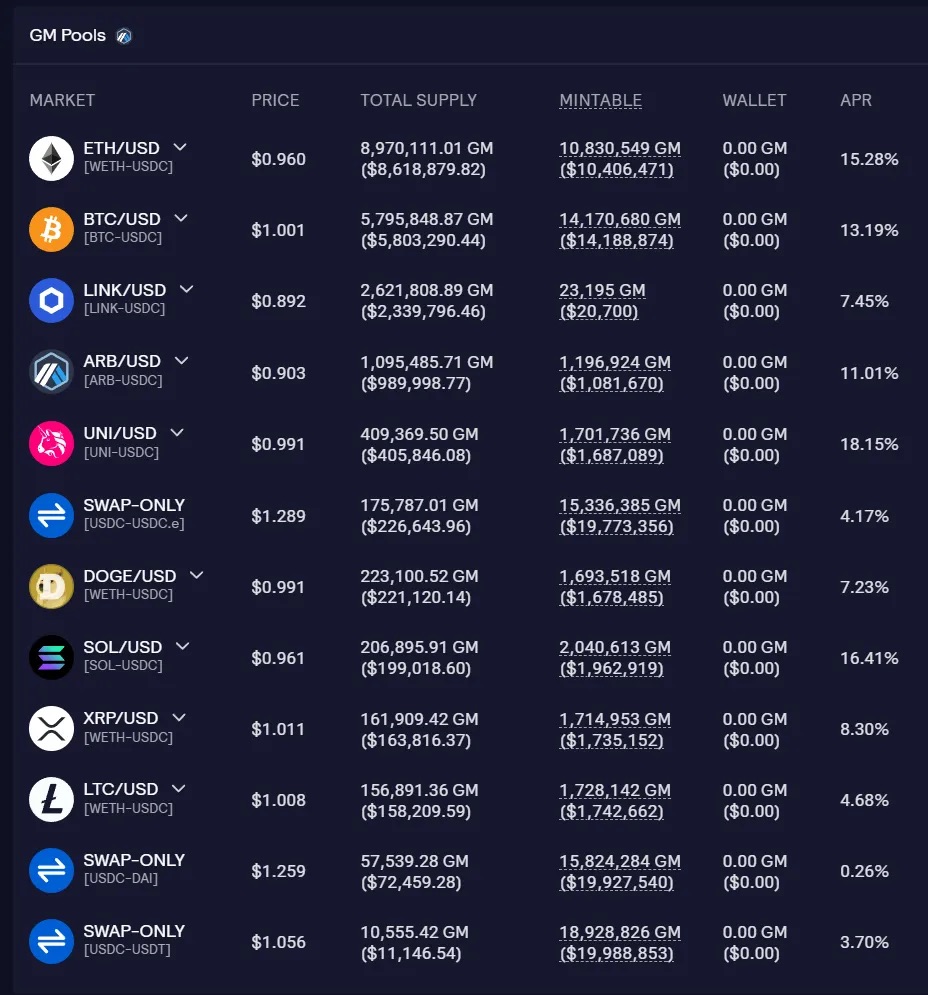
Source: GMX
After GMX V2 was launched, the market was not very popular, and the capital response was mediocre. The main reason is that the recent market volatility has dropped to a historically low level, the overall trading volume has shrunk, and the track has been involuntary, and the growth of protocol revenue has been sluggish.
4. Conclusion
GMX V1 is a successful model of the derivative DEX track, with many followers. The delivery of GMX V2 is basically in line with market expectations, showing that the GMX team has strong protocol design capabilities. From a mechanism point of view, V2 increases the balance of the liquidity pool, expands the types of trading assets, and provides a variety of collateral positions. For liquidity providers and traders, there are more investment methods, better risk balance and lower fees.
However, from the initial stage, due to the adoption of independent pools, there is a problem of fragmented liquidity, and some assets may have insufficient liquidity. In addition, the GMX project party has basically not adopted marketing actions and transaction incentives, and has not had a significant impact on the new users and new transaction volume of the agreement in the short term.
Essentially, GMX V2 focuses more on protocol infrastructure, protocol security, and balance. In the current bear market environment, focusing on the construction of the underlying structure, ensuring the security of the protocol, and using the accumulated data to design better risk parameters may be of greater help to the future development of the project in the bull market. At that time, it will be able to provide a higher capacity of open contracts, a richer trading market, and launch more marketing measures in line with the market heat to acquire more new users.






